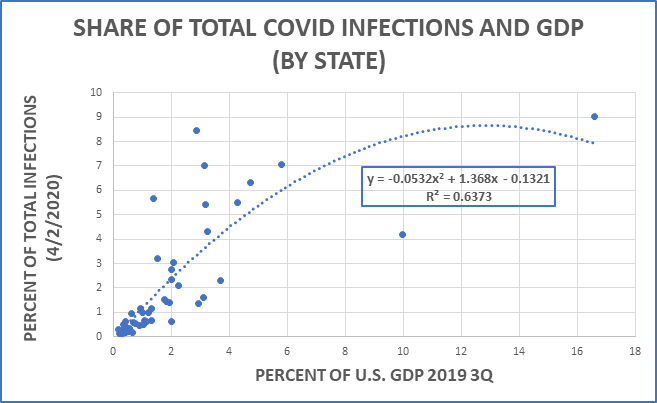We might wish to consider the COVID infection rates as a proxy for economic activity across the country. That is, areas that are more connected with the global economy (Seattle, NYC, New Jersey) would be the most exposed to international travel, but also the high density of such
places will tend to increase the ease with which it is spread. These commercial hotspots are the same places where young professionals live and work—compounding the spread.
Below, for the states in the U.S., I show you a graph depicting the percent of COVID-19 infections in each state as a percent of total U.S. infections (as of this morning, April 2), plotted against the Gross Domestic Product (GDP) in each state as a percent of the total U.S. GDP (for the 3rd quarter of 2019).
I have excluded New York and New Jersey because the extraordinary level of population density skews the picture. So we have here 48 states.
The equation in the box simply describes the dotted line (the best fit of the data).
The equation R2 = 0.6373 tells us that the percent of GDP in each state can be thought of as accounting for (but NOT causing) 64 percent of the share of infections in each state.
That is, one might reasonably infer that almost 64 percent of the variation in infections across the
U.S. is associated with the variation in the share of GDP across states. Other things enter the picture—background health status of the population, population density of the state, global-travel for residents of one or more cities in those states, etc.
California is the outlier to the far right (over 16 percent of U.S. GDP, while Texas is the outlier at about 9.9 percent of GDP yet a quite low infection rate—probably attributable to its size and the low density of its population).

Perhaps Grey Eyed Athena has decided it would be quite fitting if the richer places in the country got a little heavier dose of this unwelcome plague. Those who live in the relatively poorer states—generally more rural–might be feeling a little smug right now.
Dr. Daniel Bromley can be contact at dbromley@wisc.edu.